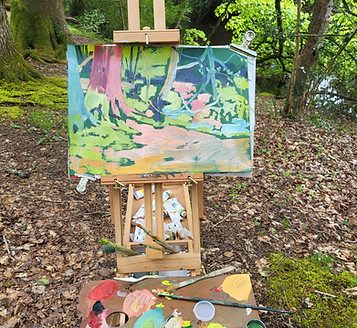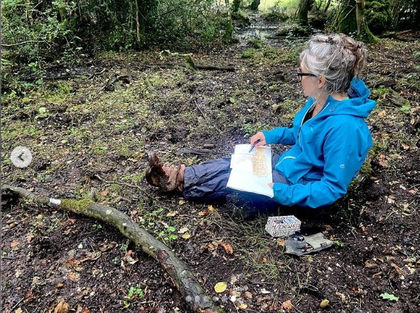
Gallery & Creative Hub

The New Forest National Park
Artist in Residence


Click on the button below to go to information on the current and past resident artists:
Melanie Rose - Residency and Exhibition
My name is Melanie Rose and I am a painter and post-doctoral fellow at the University of Leeds, although I live in Hampshire. My work is about place and the next 12 months the place that I will be investigating is the New Forest.
The New Forest was saved from enclosure in 1877 through a determined campaign of exhibitions held in London featuring the New Forest landscape. This action through art happened simultaneously to the opening of Yellowstone National Park and Fontainebleau State Park demonstrating a compulsion at the time to protect specific landscapes from industrialisation. This legacy is the starting point for my residency as I undertake to understand this unique landscape through painting and how art can be used as a vehicle for change.
Painting is core to my investigation into this place, both the act of making paintings in response to the New Forest as well as looking at historical paintings featuring the New Forest landscape. A key feature to emerge from looking at historical paintings is that landscape is ‘over there’ a theory so deeply ingrained as to disconnect us from nature. We are always ‘looking at’ landscape from a distance. I am interested in how to disrupt this pattern of looking as well as how to open up conversations about landscapes that are important to us, and the role artists play in creating avenues of debate.
Melanie will be in Residence at spudWORKS throughout May 2023 and exhibiting in the spudWORKS Gallery during October 2023. Come back here next year to follow Melanie's residency or follow on SPUD's Instagram: spud.org.uk
Week 1
Orientation
The 1st of May 2023 is a Monday and the start of my month-long residency in the New Forest. Having prepared materials and equipment in advance, I am good to go, but where and with what aims.
My first plein air excursion was to a recently visited magnificent ancient Oak at Gritnam Wood. Some might say the forest is magic, as this beautiful, gnarled Oak with elephantine protrusions had vanished into thin air or possibly the depths of the forest. So, my first set of field sketches are the roots of an upended Beech tree, but to all extents and purposes I had begun my journey into painting this rare and beautiful place.
The following day I paid homage to landscape painting, by visiting the chest tomb of William Gilpin (1724 – 1804) at St John the Baptist at Boldre. Gilpin’s theories about the picturesque will frame much of my thinking about how we look at landscape:
…but whosoever examines the wild combinations of a forest (which is a delightful study to a picturesque eye) and compares them with the attempts of art, has little taste if he do not acknowledge, with astonishment, the superiority of Nature’s workmanship. (Gilpin, Remarks on Forest Scenery and Other Woodland Views 1791)
But for now, my aim, is to make intuitive field sketches in oil paint, which I did on the way home at Shirley Holmes (carpark), a landscape rich in archaeology, whilst thinking about Gilpin and the picturesque.
The following day was a visit to Mark Ash Wood with PaC an organisation of practicing artists’ commons. Like Gilpin, Mark Ash Wood will become significant, but on this warm, sunny day, the forest floor was alive with spiders and wood ants. I have never seen anything like it in my life, the entire forest floor was alive and moving, everywhere including up my trouser legs, which I rolled up whilst drawing the magnificent Beech trees as they were springing into full leaf, in charcoal.
One of the members of PaC was reading aloud from Gorley (1910) a book by Heywood Sumner (1853 – 1940). Sumner a renowned painter, illustrator and archaeologist had divided the Forest into three sections, North, Middle and South. Here was my system about how I would embark exploring this diverse and unusual landscape.
Week 2
Middling About
The plan this week is to explore the Middle and Southern sections of the Forest, following in Heywood Sumner’s footsteps.
Ridley Wood “stands on the South-Eastern side of the highroad from Ringwood to Cadnam…this fine old wood of pollard Beeches…is approached by a hollow-way, and there is authentic hearsay tradition that this concealed hollow was used as a meeting place by smugglers…” The day I visited, lightning was forecast and weirdly the tree limb I was perched on (it was too big to sit on) was from the scorched scar of a lightning strike on the tree in front of me – I took this as an omen.
South - (Ivy Wood) My aim was Denny Wood, but access was an issue, so I headed back along the Beaulieu Road, with views of the Isle of Wight to my left as I headed back across wide open, Gorse covered heathland and “bustle-headed” trees shaped by offshore prevailing winds. My next thought was Woodfidley, but that is now Private Property, so I ended up next to a meandering brook in Ivy Wood.
Pondhead Inclosure & Charcoal Burning: Pondhead is Crown land and has been officially managed by an award-winning conservation trust since 2014. Spearheaded by Dave Dibden and Derek Tippetts, this beautiful woodland, unlike the rest of the forest doesn’t have the famous browse line as ponies and cattle are fenced out. Derek met me at the gate and took me on a tour of the woodland before introducing me to Mike and Phil who had been busy since early that morning, lighting the kilns to make charcoal. I spent the rest of the day listening to conversations about the Forest whilst drawing scenes of this ancient craft.
Week 3
NORTH
Anses Wood:
“old Beech, Oak and Holly…bounded by the twisting upper course of Dockenswater which perfects the charm of this, the most beautifully wooded bottom in the Northern area.” (Sumner, 1924)
The day I visited Anses Wood (mid-May) it was freezing, even with waterproofs and woolly hat, but determined, I sat out and painted both the ancient woodland and pond with waterfowl including, protective Canada Geese and their goslings.
By the evening the wind had changed direction and the sun felt warm again, perfect timing for a six-mile circular walk from Sway, with New Forest guide Robbie Steen. Taking in forest and heath, valley-mire and river, Steen brought the landscape to life by pointing out features of interest including a four-hundred-year-old Badger set, Neolithic burial sites, ancient tracks and wildlife.
Bolderwood - Radnor Trail & Barrow Moor:
On this day, I didn’t get as far North as planned but took myself on a New Forest National Park trail. The perfect way to access the forest, although my preferences are less managed places where the only paths are made by animals. which I found at Barrow Moor.
In the evening I met up with Jim Mitchell from the New Forest National Park who took us out to listen to Nightjars. Not only did we hear this nocturnal bird which according to the RSPB has “an almost supernatural reputation with their silent flight and their mythical ability to steal milk from goats” but one flew over our heads and then not long after that, in near darkness a Barn Owl flew along the treeline.
Fritham:
Standing barefoot on soft springy moss in a circle of ancient Oaks is both grounding and restorative. The act of standing still in ancient woodland out of earshot of cars is a form of meditation as is, for me, drawing, which also slows the mind. Focused concentration not only solidifies visual information, but time elapses.
North & South
Heading North through the Ornamental Drive, high up on the heath are two solitary trees that have been struck by lightning. Today they are sun-bleached, skeletal monuments standing proud on the skyline, drawing in the passer-by for a closer look.
Crossing back to the car I noticed a solitary wooden cross. The Canadian War Memorial to soldiers stationed in the New Forest during WW2 before the D-Day Invasion. The gated memorial revealed wreaths, poppies, mementoes, and photographs to those killed in battle. The location added to the poignancy of loss.
Heading further North to Fordingbridge, I set out to visit the statue of the painter Augusts John. Researching dates and location, I would think Heywood Sumner and John may have crossed paths, certainly John was a controversial character, not particularly liked by villagers as well as an inconsistent painter compared to his sister Gwen, whose paintings surpass her brothers.
Then back South via sand dunes at Linford a Mediaeval enclosure to the The Turfcutters Arms and their Listening Station https://www.the-turfcutters-new-forest.co.uk/east-boldre-oral-history-project/ before walking out across the heath adjacent to the pub to locate the Beaulieu Letters carved into the ground to mark a landing strip during WWI.
![IMG_20230501_211600_931[1].jpg](https://static.wixstatic.com/media/23bd29_25728e8543c04977a5f7909eac5a92ea~mv2.jpg/v1/crop/x_0,y_176,w_1440,h_1025/fill/w_529,h_376,al_c,q_80,usm_0.66_1.00_0.01,enc_avif,quality_auto/IMG_20230501_211600_931%5B1%5D.jpg)
![20230501_165551[1].jpg](https://static.wixstatic.com/media/23bd29_45b50c8e8cb9444a8d108e320e7c8339~mv2.jpg/v1/crop/x_0,y_410,w_3000,h_3191/fill/w_353,h_376,al_c,q_80,usm_0.66_1.00_0.01,enc_avif,quality_auto/20230501_165551%5B1%5D.jpg)
![IMG_20230502_185929_117[1].jpg](https://static.wixstatic.com/media/23bd29_5bf563c3715349d28b366032b5d6a65b~mv2.jpg/v1/crop/x_88,y_325,w_1261,h_960/fill/w_431,h_328,al_c,q_80,usm_0.66_1.00_0.01,enc_avif,quality_auto/IMG_20230502_185929_117%5B1%5D.jpg)








































